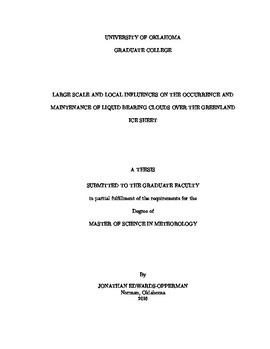| dc.description.abstract | Arctic liquid bearing clouds (LBCs) have a large impact on the surface radiation and cryospheric mass budgets. Their effect on the surface radiation budget is a combination of two competing processes. First, they can prevent incoming solar radiation from reaching the ground - a function of cloud optical thickness. Second, they absorb terrestrial infrared radiation - a function of the amount of liquid water in the cloud - and emit in the infrared back to the surface thus preventing effective radiative cooling of the surface. Arctic LBCs are frequently observed and can persist for up to several days at time. Their persistence is due to a combination of local processes, such as cloud top radiative cooling and turbulence, and factors relating to the large-scale atmospheric setup, such as moisture advection and large-scale vertical motion. Given their longevity and influence on the Arctic surface, it is of interest to explore the factors that contribute to their occurrence over Summit, Greenland.
The Integrated Characterization of Energy, Clouds, Atmospheric State and Precipitation at Summit (ICECAPS) project has been collecting data at Greenland’s Summit Station (elevation 3200 m above sea level) from a suite of remote sensors designed to measure cloud and tropospheric properties since the summer of 2010. Using these data, 326 liquid bearing cloud events lasting at least 6 hours have been identified over the period June 1, 2010-September 30, 2015. LBCs are observed at Summit more frequently during the negative phase of the North Atlantic Oscillation. They also occur more frequently during summer months (JJA) with decreases in occurrence in each following season with a minimum in spring (MAM). Moisture transport to the top of the Greenland Ice Sheet from both horizontal advection and orographic lift is found to coincide with LBC events. The flow patterns leading to moisture transport to Summit are highly related to the phase of the NAO. During the positive phase of the NAO, low pressure systems track along the southeastern coast of the ice sheet. Wraparound flow from these cyclones leads to flow at Summit originating from the southeast. During the negative phase, strong ridging over the ice sheet leads to southwesterly flow toward Summit.
Microphysical properties of LBCs occurring at Summit exhibit strong seasonal cycles with maxima in liquid water path, ice water path, and precipitation occurring during the summer and minima occurring during the spring. Both liquid water path and precipitable water vapor observed at Summit are weakly related to the phase of the NAO with higher values observed during the negative phase when strong ridging over the ice sheet leads to southwesterly flow toward Summit. Ice water path and precipitation rate are unrelated to the large scale atmospheric setup. | en_US |
